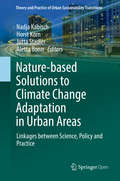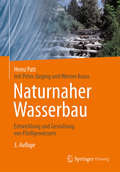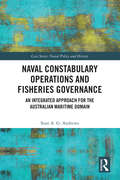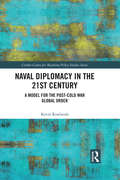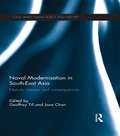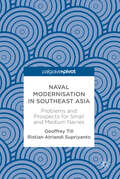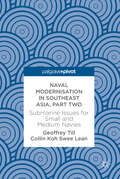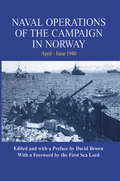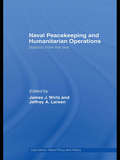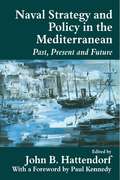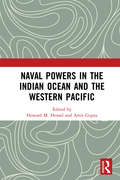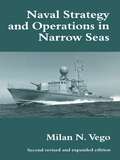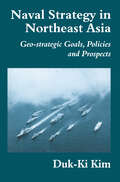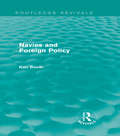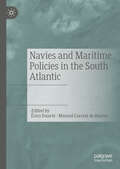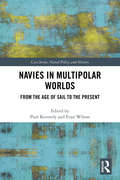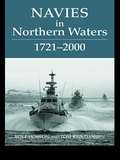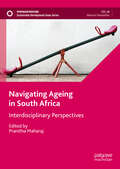- Table View
- List View
Nature-Based Solutions in Cities of the Global South
by Masoumeh Mirsafa Fabiano Lemes de OliveiraThis book explores the practice of Nature-Based Solutions (NBS) in the cities of the Global South. NBS are recognized as a key strategy for achieving sustainable development, and they are being implemented in a variety of sectors such as urban planning, agriculture, forestry, and water management. They offer a wide range of benefits, but there is a gap between research and practice across cities from the Global South. This book promotes implemented urban NBS projects in the Global South to help identify region-specific challenges and opportunities, and to develop more effective and equitable solutions. The presented case studies support resilient planning in the Global South and significantly inform urban debates in the Global North. This book offers pragmatic policy and planning recommendations, providing decision-makers with clear guidance on implementing NBS in urban settings and transforming knowledge into actionable strategies for sustainable and resilient urban development.
Nature-Based Solutions to 21st Century Challenges
by Robert C. BrearsThis book provides a systematic review of nature-based solutions and their potential to address current environmental challenges. In the 21st century, society is faced by rapid urbanisation and population growth, degradation and loss of natural capital and associated ecosystem services, an increase in natural disaster risks, and climate change. With growing recognition of the need to work with ecosystems to resolve these issues there is now a move towards nature-based solutions, which involve utilising nature’s ecosystem to solve societal challenges while providing multiple co-benefits. This book systematically reviews nature-based solutions from a public policy angle, assessing policy developments which encourage the implementation of nature-based solutions to address societal challenges while simultaneously providing human well-being and biodiversity benefits. This includes enhancing sustainable urbanisation, restoring degraded ecosystems, mitigating and adapting to climate change, and reducing risks from natural disasters. While nature-based solutions can be applied strategically and equitably to help societies address a variety of climatic and non-climatic challenges, there is still a lack of understanding on how best to implement them. The book concludes by providing a best practice guide for those aiming to turn societal challenges into opportunities. This book will be of great interest to policymakers, practitioners and researchers involved in nature-based solutions, sustainable urban planning, environmental management, and sustainable development generally.
Nature-Based Solutions to Climate Change Adaptation in Urban Areas: Linkages between Science, Policy and Practice (Theory and Practice of Urban Sustainability Transitions)
by Aletta Bonn Nadja Kabisch Horst Korn Jutta StadlerThis open access book brings together research findings and experiences from science, policy and practice to highlight and debate the importance of nature-based solutions to climate change adaptation in urban areas. Emphasis is given to the potential of nature-based approaches to create multiple-benefits for society.The expert contributions present recommendations for creating synergies between ongoing policy processes, scientific programmes and practical implementation of climate change and nature conservation measures in global urban areas.Except where otherwise noted, this book is licensed under a Creative Commons Attribution 4.0 International License. To view a copy of this license, visit http://creativecommons.org/licenses/by/4.0/
Nature-based Solutions for Sustainable Urban Planning: Greening Cities, Shaping Cities (Contemporary Urban Design Thinking)
by Fabiano Lemes de Oliveira Davide Geneletti Israa H. Mahmoud Eugenio MorelloUrban greening policies and measures have recently shown a high potential impact on the design and reshaping of the built environment, especially in urban regeneration processes. This book provides insights on analytical methods, planning strategies and shared governance tools for successfully integrating Nature-Based Solutions (NBS) in the urban planning practice. The selected contributions present real-life application cases, in which the mainstreaming of NBS are investigated according to two main challenges: the planning and designing of physical and spatial integration of NBS in cities on one side, and the implementation of suitable shared governance models and co-creation pathways on the other. Chapter 5 is available open access under a Creative Commons Attribution 4.0 International License via link.springer.com.
Naturnaher Wasserbau
by Heinz Patt Peter Jürging Werner KrausDer Autor stellt die wichtigsten Grundlagen für die Planung und Durchführung naturnaher Maßnahmen an Fließgewässern dar. Dabei behandelt er Technik und Ökologie als gleichwertige Partner. Hinweise zur aktuellen rechtlichen Situation, zum Planungsablauf sowie neue Aspekte der Gewässerunterhaltung sind ebenso enthalten wie hydrologische, hydraulische und sedimentologische Grundlagen. Die 4. Auflage berücksichtigt die Neufassungen zahlreicher Gesetze, u. a. des Bundesnaturschutzgesetzes, sowie das seit April 2010 gültige Wasserhaushaltsgesetz.
Naturnaher Wasserbau: Entwicklung und Gestaltung von Fließgewässern
by Heinz PattDer Autor stellt die wichtigsten Grundlagen für die Planung und Durchführung naturnaher Maßnahmen an Fließgewässern dar. Dabei behandelt er Technik und Ökologie als gleichwertige Partner. Hinweise zur aktuellen rechtlichen Situation, zum Planungsablauf sowie neue Aspekte der Gewässerunterhaltung sind ebenso enthalten wie hydrologische, hydraulische und sedimentologische Grundlagen. Die 4. Auflage berücksichtigt die Neufassungen zahlreicher Gesetze, u. a. des Bundesnaturschutzgesetzes, sowie das seit April 2010 gültige Wasserhaushaltsgesetz.
Naufragios: Crónica de mi viaje personal
by Esteban ValentiPersonaje polémico si los hay, Esteban Valenti se propone abrir esta "ventana de sinceridad" para exponer su camino vital, no exento de contradicciones, fallos y desengaños. Esteban Valenti plantea en este libro una revisión de su vida, las peripecias que ha tenido a lo largo de los años, y su participación en el accionar político desde diversos ámbitos. Se revela como una personalidad compleja, por momentos contradictoria, que ha dedicado la mayor parte de su existencia a la participación en la actividad política. Este libro finaliza analizando el fracaso del proyecto La Alternativa, y revelando los pormenores de ese proceso.
Naval Blockades and Seapower: Strategies and Counter-Strategies, 1805-2005 (Cass Series: Naval Policy and History)
by Bruce Allen Elleman Sarah C.M. PaineThis new collection of scholarly, readable, and up-to-date essays covers the most significant naval blockades of the nineteenth and twentieth centuries. Here the reader can find Napoleon’s Continental Blockade of England, the Anglo-American War of 1812, the Crimean War, the American Civil War, the first Sino-Japanese War 1894-95, the Spanish-American War, the First World War, the second Sino-Japanese War 1937-45, the Second World War in Europe and Asia, the Nationalist attempt to blockade the PRC, the Korean War, the Cuban Missile Crisis, the Vietnam War, the British blockade of Rhodesia, the Falklands War, the Persian Gulf interdiction program, the PRC "missile" blockade of Taiwan in 1996, and finally Australia's recent "reverse" blockade to keep illegal aliens out of the country. The authors of each chapter address the causes of the blockade in question, its long and short-term repercussions, and the course of the blockade itself. More generally, they address the state of the literature, taking advantage of new research and new methodologies to provide something of value to both the specialist and non-specialist reader. Taken as a whole, this volume presents fresh insights into issues such as what a blockade is, why countries might choose them, which navies can and cannot make use of them, what responses lead to satisfactory or unsatisfactory conclusions, and how far-reaching their consequences tend to be. This book will be of great interest to all students and scholars of strategic studies, military history and maritime studies in particular.
Naval Constabulary Operations and Fisheries Governance: An Integrated Approach for the Australian Maritime Domain (ISSN)
by Sean A. AndrewsThis book offers an analysis of naval constabulary operations, in particular Australian fisheries patrols, and challenges the widely accepted Anglo-American school of maritime thought.In the Indo-Pacific, fisheries and the activities of fishing boats are of increasing strategic importance in Australia’s region – Australia’s Four Oceans. Issues of overfishing, population growth and climate change are placing growing pressure on fish as a resource, and in doing so are making fisheries more significant, and significant on a strategic as opposed to simply an economic or environmental level. When, combined with the growing use of fishing vessels as para-naval forces, it is clear that the activities of fishing vessels, whether fishing or not fishing, are matters of considerable strategic relevance. This book illuminates contemporary seapower challenges, explains and defines maritime security and examines and refines existing theory to advance a set of new or refined concepts to help frame the on-water activities of constabulary operations -- reducing the possibility of on-water miscalculation between states.This book will be of much interest to students and scholars of naval studies and sea power, maritime strategy, maritime security and International Relations.
Naval Diplomacy in 21st Century: A Model for the Post-Cold War Global Order (Corbett Centre for Maritime Policy Studies Series)
by Kevin RowlandsThis book offers a detailed investigation of naval diplomacy, past and present, and challenges the widely accepted Anglo-American school of sea power thought. Despite the acknowledgement of the importance of the threat or use of force in the pursuit of policy since the dawn of strategic thought, the utility of seapower in operations other than war is poorly understood and articulated. Theorists have invariably viewed seapower in peacetime through the lens of hard power effects such as coercion and deterrence. Commentaries on engagement, interoperability and the forging of friendships are largely conspicuous by their absence. This book considers how all these strands of international politics can be better understood for use in the 21st century. The book explains and defines naval diplomacy, with existing theoretical frameworks being critically analysed. It reviews over 500 incidents from the post-Cold War era, drawing on this empirical evidence to determine that naval diplomacy remains a potent means of 21st century statecraft. It finds that existing understanding of naval diplomacy is insufficient and offers an alternative model, drawing on basic communication and stakeholder theories. The implications of the book relate directly to national security: naval deployments could be more effectively targeted; foreign activity at sea could be better understood and, if necessary, countered; finally, the ability of non-state actors to support national interests from the sea could, potentially, be better harnessed. This book will be of much interest to students of naval power, maritime security, strategic studies and International Relations.
Naval Modernisation in South-East Asia: Nature, Causes and Consequences (Cass Series: Naval Policy and History)
by Geoffrey Till Jane ChanThis edited volume analyses the naval arms race in South-East Asia, and reviews the content, purposes and consequences of the naval policies and development of the main countries of the region. The rise of naval capability in the countries of the Asia-Pacific Region is increasingly recognised as a major indicator of the ‘rise of Asia’ and its increasing importance in the world’s political, economic and strategic future. Most coverage focusses solely on the navies of the 'big four' – the US, China, India and Japan; however, the region’s other navies, though much smaller, are significant too. Given the current focus on the South China Sea and the Obama administration’s pivot to Asia, naval development in South-East Asia is of particular relevance. This book first identifies the issues involved in defence acquisition in this area. It then goes on to establish some templates of naval modernisation as a means of assessing the policies of individual countries in the region, by looking at the naval policies of the big four. Finally, the general issue of naval modernisation in South-East Asia is illustrated through a more detailed examination of some of the major issues common to all countries of the area. These include the defence-industrial perspective, specific examinations of submarine and surface ship acquisition processes, and a review of the balance to be struck between naval and coastguard forces in the area. This book will be of much interest to students of naval power, maritime security, South-East Asian politics, strategic studies, and IR in general.
Naval Modernisation in Southeast Asia
by Geoffrey Till Ristian Atriandi SupriyantoThis edited volume reviews the nature and consequences of naval modernisation in Southeast Asia against the backdrop of growing tensions over the South China Sea and increasing competition between the United States and China in the region. The varying problems and challenges facing the small and medium navies of the area as they seek to grow their maritime power in response to their perceptions of strategic need are compared and contrasted. The prospects of significant destabilisation of an already volatile area - even of a potential naval arms race, are carefully analysed. There can be little doubt that naval modernisation in Southeast Asia is a key indicator of the likely future of the Asia Pacific and also illustrates the problems faced by small and medium powers in a world dominated by the great. Accordingly this book will be of much interest to students and teachers focusing on security in the Asia Pacific region as well to those concerned with naval development in genera l.
Naval Modernisation in Southeast Asia, Part Two
by Geoffrey Till Collin Koh Swee LeanThis edited volume starts with an account of the submarine in naval warfare and moves on to review the nature and consequences of naval modernisation in Southeast Asia by considering their acquisition by the small and medium navies of the region. It explores the reasons for these navies taking on this very substantial and demanding challenge, the problems they are facing and the consequences of the deployment of submarines for regional stability. Given the backdrop of growing tensions over the South China Sea and increasing competition between the United States and China in the region, will the arrival of submarines in the area help or hinder the cause of peace? This volume will be of substantial interest not just to those interested in submarines and naval development but also to students and teachers concerned about the very volatile developing situation in and around the South China Sea.
Naval Operations of the Campaign in Norway, April-June 1940 (Naval Staff Histories)
by David BrownThis is the official Naval Staff history of the Norway campaign, originally published internally in 1951. It covers the period from early April 1940 to the completion of operations in June. The operation involved most of the Royal Navy's ships in the Home theatre at the time.
Naval Peacekeeping and Humanitarian Operations: Stability from the Sea (Cass Series: Naval Policy and History)
by James J. Wirtz Jeffrey A. LarsenThis edited volume explores stability, security, transition and reconstruction operations (SSTR), highlighting the challenges and opportunities they create for the US Navy. The book argues that SSTR operations are challenging because they create new missions and basing modes, and signal a return to traditional naval methods of operation. Mission accomplishment requires collaboration with a wide range of actors representing governmental, non-governmental and commercial organizations, which often creates politically and bureaucratically charged issues for those involved. However, although from a traditional warfighting perspective, stability operations might be viewed as having little to do with preparing for high-intensity conventional combat, these kinds of operations in fact correspond to traditional missions related to diplomacy, engagement, maritime domain awareness, piracy and smuggling, and intervention to quell civil disturbances. SSTR operations can be therefore depicted as a return to traditional naval operations, albeit operations that might not be universally welcomed in all quarters.
Naval Policy and Strategy in the Mediterranean: Past, Present and Future (Cass Series: Naval Policy and History #No. 10)
by John B. HattendorfMaritime strategy and naval power in the Mediterranean touches on migration, the environment, technology, economic power, international politics and law, as well as calculations of naval strength and diplomatic manoeuvre. These broad and fundamental themes are explored in this volume.
Naval Powers in the Indian Ocean and the Western Pacific
by Amit Gupta Howard M. HenselA vital component of the interdependent global economy, maritime transit routes are nowhere more critical than those traversing the Indian Ocean and the Western Pacific. Previously, areas of the Indian Ocean and Western Pacific have been viewed as separate and discrete political, economic, and military regions. In recent years, however, a variety of economic, political, and military forces have created a new understanding of these maritime expanses as one zone of global interaction. <P><P>This book complements the material presented in its companion volume, Maritime Security in the Indian Ocean and the Western Pacific, by analysing the perceptions, interests, objectives, maritime capabilities, and policies of the major maritime powers operating in the Indian Ocean and the Western Pacific. In addition, the book also assesses the contemporary maritime challenges and opportunities that confront the global community within what is rapidly becoming recognised as an integrated zone of global interaction. <P><P>A valuable study for researchers and policymakers working in the fields of maritime security; military, security and peace studies; conflict resolution; and Asian affairs.
Naval Strategy and Operations in Narrow Seas
by Milan N. VegoMany books and articles have been written on wars in narrow seas. However, none deals in any comprehensive manner with the problems of strategy and conduct of naval operations. The aim of this book is to explain in some detail the characteristics of a war fought in narrow seas and to compare and contrast strategy and major operations in narrow seas and naval warfare in the open ocean..
Naval Strategy in Northeast Asia: Geo-strategic Goals, Policies and Prospects (Cass Series: Naval Policy and History)
by Duk-Ki KimOver the past decade, Northeast Asia has been dominated by quite significant strategic change, which is ongoing and brings with it many uncertainties. naval capabilities in Northwest Asia are instrumental in promoting maritime security interests - helping to build a stable security environment through active participation in regional naval co-operation. This landmark book explores the region's maritime peace and stability, and examines in depth the strategic, military and apolitical issues that underpin any effort to develop maritime co-operation.
Navies and Foreign Policy (Routledge Revivals)
by Ken BoothFirst published in 1977, this study offers a comprehensive, systematic and integrated survey of the important relationship between navies and the making and execution of foreign policy. Ken Booth explains the functions navies can perform in both war and peace, the influence they have on particular situations, and how the relevant organisations can affect the character of naval actions. Ultimately, navies are regarded as indispensable instruments of the state by a number of countries, whilst all countries with a coast find some need to threaten a degree of force at sea. This book provides students and academics with the intellectual framework with which to assess the changing character of the navy.
Navies and Maritime Policies in the South Atlantic
by Érico Duarte Manuel Correia de BarrosThis edited volume analyzes national security issues with maritime implications, and, specifically, naval projects and postures of main South Atlantic countries: Brazil, Argentina, Nigeria, and South Africa. Additionally, it provides comprehensive and multi-level analysis of the interplay among national interests in the processes of demarcation of limits of the continental shelf and contention among Uruguay, Chile, Argentina, and the United Kingdom in the Southern Atlantic and the Antarctica. This book will interest scholars, researchers, and students in the fields of Latin American politics, regional studies, foreign and defense policy, and maritime security.
Navies in Multipolar Worlds: From the Age of Sail to the Present (Cass Series: Naval Policy and History)
by Paul Kennedy Evan WilsonRecent challenges to US maritime predominance suggests a return to great power competition at sea, and this new volume looks at how navies in previous eras of multipolarity grappled with similar challenges. The book follows the theme of multipolarity by analysing a wide range of historical and geographical case studies, thereby maintaining the focus of both its historical analysis and its policy implications. It begins by looking at the evolution of French naval policy from Louis XIV through to the end of the nineteenth century. It then examines how the British responded to multipolar threat environments, convoys, the challenges of demobilization, and the persistence of British naval power in the interwar period. There are also contributions regarding Japan’s turn away from the sea, the Italian navy, and multipolarity in the Arctic. This volume also addresses the regional and global distribution of forces; trade and communication protection; arms races; the emergence of naval challengers; fleet design; logistics; technology; civil-naval relations; and grand strategy, past, present, and future. This book will be of much interest to students of naval history, strategic studies and international relations history, as well as senior naval officers.
Navies in Northern Waters (Cass Series: Naval Policy and History #Vol. 26)
by Rolf Hobson Tom KristiansenNavies in Northern Waters is a collection of articles covering the roles played by the secondary navies of northern European powers and the United States within the maritime balance of power. The contributions covering the 18th and 19th centuries focus on their relations with each other as they sought to create a counterweight to the dominant naval power of Britain. The inter-war years are treated from the perspectives of international disarmament efforts within the framework of collective security, and the subsequent naval rivalry in the Baltic area in the years leading up to the Second World War. For the post-1945 period, the contributions concentrate on superpower rivalry in northern waters during the Cold War, the changing aspects of security policy since the collapse of the Soviet Union and the particular challenges facing small coastal states policing extensive waters of increasing economic importance.
Navies of South-East Asia: A Comparative Study (Cass Series: Naval Policy and History)
by James Goldrick Jack McCaffrieThis book provides a comprehensive survey of the development and operations of the navies of South-East Asia since the end of World War II. The navies of South-East Asia have rarely been the subject of systematic attention but, as the maritime strategic balance within Asia becomes more complex and open to challenge through the rise of China, they will play increasingly significant roles. While most have had only limited strength in the past, the majority are acquiring new capabilities, notably submarines, which will profoundly alter their ability to influence events. This volume outlines the difficulties that each navy has faced in developing capability in competition, not only with local armies and air forces, but with other national requirements. The authors analyse the way in which each has been shaped by history and by changing maritime strategic concepts, particularly through developments such as the 1982 Law of the Sea Convention. Drawing upon this contextual information, the book goes on to examine how the navies are likely to develop in the future, what new challenges they will face and the nature of the roles they will play within a region of increasing global strategic significance. This book will be of much interest to students of naval policy, SE Asian politics, regional security, strategic studies and IR in general.
Navigating Ageing in South Africa: Interdisciplinary Perspectives (Sustainable Development Goals Series)
by Pranitha MaharajThis book systematically explores the lives and varied experiences of older people in South Africa. Though a relatively youthful country, the share of the population aged sixty and above in South Africa is increasing steadily and is projected to reach 10% of the population by 2025. Population ageing is having major and far-reaching implications for a country with widespread poverty, changing household structures, a heavy burden of communicable diseases, and inadequate health infrastructure. Pandemics, such as HIV/AIDS and COVID-19, exacerbate many of the challenges faced by older people. Drawing on original research from national surveys and case studies, this book explores the various experiences and challenges of older people in their daily lives, such as their healthcare, social and family lives, their socio-economic status, mental health, and what it means to be an older person in South Africa today.


